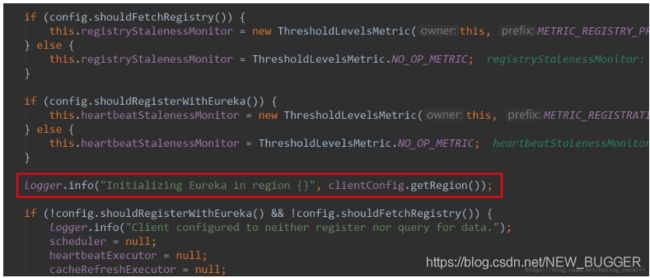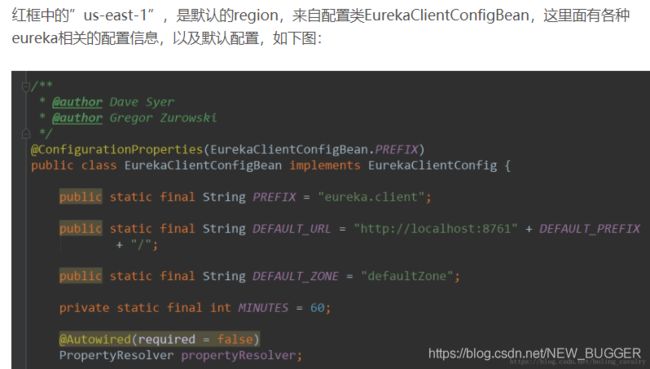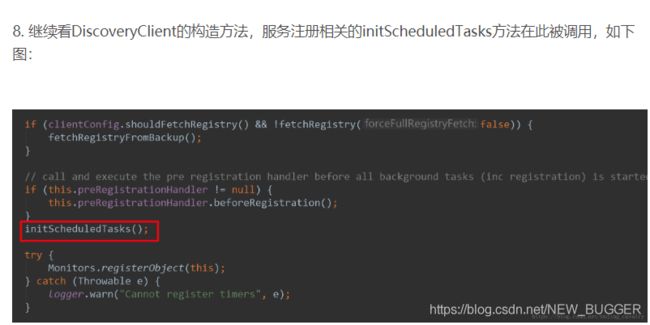二、Eureka源码解析:服务注册以及注册信息的更改(包含客户端和服务的源码详解)
1、 spring-cloud-netflix-eureka-client-1.4.0.RELEASE.jar是个重要的jar包,很多配置都在此jar内部的spring.factories文件中,首先要确定这个jar包是否会出现在应用的classpath中(如果不在classpath中,这些配置就不会生效),在pom.xml所在目录下执行命令mvn dependency:tree,打印依赖树,如下图,可确认spring-cloud-netflix-eureka-client被启动器spring-cloud-starter-netflix-eureka-client间接依赖,因此会出现在classpath中。
2.通过 spring-cloud-netflix-eureka-client-1.4.0.RELEASE.jar中的spring.factories文件
springboot启用了自动配置,那么EurekaClientConfigServerAutoConfiguration、……、EurekaDiscoveryClientConfiguration等五个配置类都会生效;
3. 按照spring.factories中的配置,EurekaClientAutoConfiguration中的配置都会生效,包括下面这段代码返回的bean:
@Bean
public DiscoveryClient discoveryClient(EurekaInstanceConfig config, EurekaClient client) {
return new EurekaDiscoveryClient(config, client);
}
4. spring容器初始化时会实例化所有单例bean,就会执行EurekaClientAutoConfiguration的discoveryClient方法获取这个bean实例,于是就构造了一个EurekaDiscoveryClient对象;
5. 注意EurekaDiscoveryClient的构造方法,第二个入参是com.netflix.discovery.EurekaClient类型,此对象同样来自EurekaClientAutoConfiguration类,如下方法:
@Bean(destroyMethod = "shutdown")
@ConditionalOnMissingBean(value = EurekaClient.class, search = SearchStrategy.CURRENT)
@org.springframework.cloud.context.config.annotation.RefreshScope
@Lazy
public EurekaClient eurekaClient(ApplicationInfoManager manager, EurekaClientConfig config, EurekaInstanceConfig instance) {
manager.getInfo(); // force initialization
return new CloudEurekaClient(manager, config, this.optionalArgs,this.context);
}
CloudEurekaClient的父类com.netflix.discovery.DiscoveryClient来自netflix发布的eureka-client包中,所以可以这么理解:EurekaDiscoveryClient类是个代理身份,真正的服务注册发现是委托给netflix的开源包来完成的,我们可以专心的使用SpringCloud提供的服务注册发现功能,只需要知道EurekaDiscoveryClient即可,真正的服务是eureka-client来完成的;
6. 接下来需要关注com.netflix.discovery.DiscoveryClient的构造方法,因为这里面有服务注册的逻辑,整个构造方法内容太多,无需都细看,只看关键代码即可;
7. DiscoveryClient的构造方法中,最熟悉的应该是下图红框中这段日志输出的了:
9. initScheduledTasks方法的内容如下,请注意中文注释:
private void initScheduledTasks() {
//获取服务注册列表信息
if (clientConfig.shouldFetchRegistry()) {
//服务注册列表更新的周期时间
int registryFetchIntervalSeconds = clientConfig.getRegistryFetchIntervalSeconds();
int expBackOffBound = clientConfig.getCacheRefreshExecutorExponentialBackOffBound();
//定时更新服务注册列表
scheduler.schedule(
new TimedSupervisorTask(
"cacheRefresh",
scheduler,
cacheRefreshExecutor,
registryFetchIntervalSeconds,
TimeUnit.SECONDS,
expBackOffBound,
new CacheRefreshThread() //该线程执行更新的具体逻辑
),
registryFetchIntervalSeconds, TimeUnit.SECONDS);
}
if (clientConfig.shouldRegisterWithEureka()) {
//服务续约的周期时间
int renewalIntervalInSecs = instanceInfo.getLeaseInfo().getRenewalIntervalInSecs();
int expBackOffBound = clientConfig.getHeartbeatExecutorExponentialBackOffBound();
//应用启动可见此日志,内容是:Starting heartbeat executor: renew interval is: 30
logger.info("Starting heartbeat executor: " + "renew interval is: " + renewalIntervalInSecs);
// 定时续约
scheduler.schedule(
new TimedSupervisorTask(
"heartbeat",
scheduler,
heartbeatExecutor,
renewalIntervalInSecs,
TimeUnit.SECONDS,
expBackOffBound,
new HeartbeatThread() //该线程执行续约的具体逻辑
),
renewalIntervalInSecs, TimeUnit.SECONDS);
//这个Runable中含有服务注册的逻辑
instanceInfoReplicator = new InstanceInfoReplicator(
this,
instanceInfo,
clientConfig.getInstanceInfoReplicationIntervalSeconds(),
2); // burstSize
statusChangeListener = new ApplicationInfoManager.StatusChangeListener() {
@Override
public String getId() {
return "statusChangeListener";
}
@Override
public void notify(StatusChangeEvent statusChangeEvent) {
if (InstanceStatus.DOWN == statusChangeEvent.getStatus() ||
InstanceStatus.DOWN == statusChangeEvent.getPreviousStatus()) {
// log at warn level if DOWN was involved
logger.warn("Saw local status change event {}", statusChangeEvent);
} else {
logger.info("Saw local status change event {}", statusChangeEvent);
}
instanceInfoReplicator.onDemandUpdate();
}
};
if (clientConfig.shouldOnDemandUpdateStatusChange()) {
applicationInfoManager.registerStatusChangeListener(statusChangeListener);
}
//服务注册
instanceInfoReplicator.start(clientConfig.getInitialInstanceInfoReplicationIntervalSeconds());
} else {
logger.info("Not registering with Eureka server per configuration");
}
}
10.注册逻辑后续
instanceInfoReplicator.start(clientConfig.getInitialInstanceInfoReplicationIntervalSeconds());
public void run() {
try {
https://blog.csdn.net/u012394095/article/details/80966441
// 该方法负责比对客户端存在的instance信息和实际的信息,是否发生改变
// 比如: 客户端的状态,IP,配置信息发生改变,如果发生改变则dirtyTimestamp不为null。
discoveryClient.refreshInstanceInfo();
// 判断信息是否改变,是否需要重新注册。通过isInstanceInfoDirty这个布尔值判断
Long dirtyTimestamp = instanceInfo.isDirtyWithTime();
if (dirtyTimestamp != null) {
// 注册( //如果实例信息发生改变,则需要调用register更新InstanceInfo)
discoveryClient.register();
// 取消
instanceInfo.unsetIsDirty(dirtyTimestamp);
}
} catch (Throwable t) {
logger.warn("There was a problem with the instance info replicator", t);
} finally {
//之后40秒之后重新刷新注册更新或者更新信息
Future next = scheduler.schedule(this, replicationIntervalSeconds, TimeUnit.SECONDS);
scheduledPeriodicRef.set(next);
}
}
11、 真正实现注册discoveryClient.register();
/**
* Register with the eureka service by making the appropriate REST call.
*/
boolean register() throws Throwable {
logger.info(PREFIX + appPathIdentifier + ": registering service...");
EurekaHttpResponse
try {
//注册操作
httpResponse = eurekaTransport.registrationClient.register(instanceInfo);
} catch (Exception e) {
logger.warn("{} - registration failed {}", PREFIX + appPathIdentifier, e.getMessage(), e);
throw e;
}
if (logger.isInfoEnabled()) {
logger.info("{} - registration status: {}", PREFIX + appPathIdentifier, httpResponse.getStatusCode());
}
return httpResponse.getStatusCode() == 204;
}
12、eurekaTransport.registrationClient.register(instanceInfo)
主要工作是利用jersey库的Restful Api将自身的信息POST到Eureka server
@Override
public EurekaHttpResponse
String urlPath = "apps/" + info.getAppName();
ClientResponse response = null;
try {
Builder resourceBuilder = jerseyClient.resource(serviceUrl).path(urlPath).getRequestBuilder();
addExtraHeaders(resourceBuilder);
response = resourceBuilder
.header("Accept-Encoding", "gzip")
.type(MediaType.APPLICATION_JSON_TYPE)
.accept(MediaType.APPLICATION_JSON)
.post(ClientResponse.class, info);
return anEurekaHttpResponse(response.getStatus()).headers(headersOf(response)).build();
} finally {
if (logger.isDebugEnabled()) {
logger.debug("Jersey HTTP POST {}/{} with instance {}; statusCode={}", serviceUrl, urlPath, info.getId(),
response == null ? "N/A" : response.getStatus());
}
if (response != null) {
response.close();
}
}
}
服务端处理:
ApplicationResource
# 整体注册信息缓存
private final ConcurrentHashMap
# 最近变化队列
private ConcurrentLinkedQueue
EurekaServer收到实例注册主要分两步:
1、调用父类方法注册
2、同步到其他EurekaServer实例
public void register(InstanceInfo info, boolean isReplication) {
int leaseDuration = 90;
if (info.getLeaseInfo() != null && info.getLeaseInfo().getDurationInSecs() > 0) {
leaseDuration = info.getLeaseInfo().getDurationInSecs();
}
//调用父类方法注册
super.register(info, leaseDuration, isReplication);
//同步到其他EurekaServer实例
this.replicateToPeers(PeerAwareInstanceRegistryImpl.Action.Register, info.getAppName(), info.getId(), info, (InstanceStatus)null, isReplication);
我们先看同步到其他EurekaServer实例
其实就是,注册到的EurekaServer再依次调用其他集群内的EurekaServer的Register方法将实例信息同步过去
private void replicateToPeers(Action action, String appName, String id,
InstanceInfo info /* optional */,
InstanceStatus newStatus /* optional */, boolean isReplication) {
Stopwatch tracer = action.getTimer().start();
try {
if (isReplication) {
numberOfReplicationsLastMin.increment();
}
// If it is a replication already, do not replicate again as this will create a poison replication
if (peerEurekaNodes == Collections.EMPTY_LIST || isReplication) {
return;
}
for (final PeerEurekaNode node : peerEurekaNodes.getPeerEurekaNodes()) {
// If the url represents this host, do not replicate to yourself.
if (peerEurekaNodes.isThisMyUrl(node.getServiceUrl())) {
continue;
}
replicateInstanceActionsToPeers(action, appName, id, info, newStatus, node);
}
} finally {
tracer.stop();
}
}
private void replicateInstanceActionsToPeers(Action action, String appName,
String id, InstanceInfo info, InstanceStatus newStatus,
PeerEurekaNode node) {
try {
InstanceInfo infoFromRegistry = null;
CurrentRequestVersion.set(Version.V2);
switch (action) {
case Cancel:
node.cancel(appName, id);
break;
case Heartbeat:
InstanceStatus overriddenStatus = overriddenInstanceStatusMap.get(id);
infoFromRegistry = getInstanceByAppAndId(appName, id, false);
node.heartbeat(appName, id, infoFromRegistry, overriddenStatus, false);
break;
case Register:
node.register(info);
break;
case StatusUpdate:
infoFromRegistry = getInstanceByAppAndId(appName, id, false);
node.statusUpdate(appName, id, newStatus, infoFromRegistry);
break;
case DeleteStatusOverride:
infoFromRegistry = getInstanceByAppAndId(appName, id, false);
node.deleteStatusOverride(appName, id, infoFromRegistry);
break;
}
} catch (Throwable t) {
logger.error("Cannot replicate information to {} for action {}", node.getServiceUrl(), action.name(), t);
}
}
然后看看调用父类方法注册:
public void register(InstanceInfo registrant, int leaseDuration, boolean isReplication) {
try {
//register虽然看上去好像是修改,但是这里用的是读锁,后面会解释
read.lock();
//从registry中查看这个app是否存在
Map
//不存在就创建
if (gMap == null) {
final ConcurrentHashMap
gMap = registry.putIfAbsent(registrant.getAppName(), gNewMap);
if (gMap == null) {
gMap = gNewMap;
}
}
//查看这个app的这个实例是否已存在
Lease
if (existingLease != null && (existingLease.getHolder() != null)) {
//如果已存在,对比时间戳,保留比较新的实例信息......
} else {
// 如果不存在,证明是一个新的实例
//更新自我保护监控变量的值的代码.....
}
Lease
if (existingLease != null) {
lease.setServiceUpTimestamp(existingLease.getServiceUpTimestamp());
}
//放入registry
gMap.put(registrant.getId(), lease);
//加入最近修改的记录队列
recentlyChangedQueue.add(new RecentlyChangedItem(lease));
//初始化状态,记录时间等相关代码......
//主动让Response缓存失效
invalidateCache(registrant.getAppName(), registrant.getVIPAddress(), registrant.getSecureVipAddress());
} finally {
read.unlock();
}
}
总结起来,就是主要三件事:
1.将实例注册信息放入或者更新registry
2.将实例注册信息加入最近修改的记录队列
3.主动让Response缓存失效
服务取消CANCEL
protected boolean internalCancel(String appName, String id, boolean isReplication) {
try {
//cancel虽然看上去好像是修改,但是这里用的是读锁,后面会解释
read.lock();
//从registry中剔除这个实例
Map
Lease
if (gMap != null) {
leaseToCancel = gMap.remove(id);
}
if (leaseToCancel == null) {
logger.warn("DS: Registry: cancel failed because Lease is not registered for: {}/{}", appName, id);
return false;
} else {
//改变状态,记录状态修改时间等相关代码......
if (instanceInfo != null) {
instanceInfo.setActionType(ActionType.DELETED);
//加入最近修改的记录队列
recentlyChangedQueue.add(new RecentlyChangedItem(leaseToCancel));
}
//主动让Response缓存失效
invalidateCache(appName, vip, svip);
logger.info("Cancelled instance {}/{} (replication={})", appName, id, isReplication);
return true;
}
} finally {
read.unlock();
}
}
总结起来,也是主要三件事:
1.从registry中剔除这个实例
2.将实例注册信息加入最近修改的记录队列
3.主动让Response缓存失效
最近修改队列(每过三分钟就要清除没有变化的实体)
这个最近修改队列和消费者定时获取服务实例列表有着密切的关系
private TimerTask getDeltaRetentionTask() {
return new TimerTask() {
@Override
public void run() {
Iterator
while (it.hasNext()) {
if (it.next().getLastUpdateTime() <
System.currentTimeMillis() - serverConfig.getRetentionTimeInMSInDeltaQueue()) {
it.remove();
} else {
break;
}
}
}
};
}
这个RetentionTimeInMSInDeltaQueue默认是180s(配置是eureka.server.retention-time-in-m-s-in-delta-queue,默认是180s),可以看出这个队列是一个长度为180s的滑动窗口,保存最近180s以内的应用实例信息修改,后面我们会看到,客户端调用获取增量信息,实际上就是从这个queue中读取,所以可能一段时间内读取到的信息都是一样的。
Response缓存
Response缓存的实现类是ResponseCacheImpl,主要包括如下缓存field:
private final ConcurrentMap
private final LoadingCache
这个loadingcache的初始化:
this.readWriteCacheMap = CacheBuilder.newBuilder().initialCapacity(1000)
.expireAfterWrite(serverConfig.getResponseCacheAutoExpirationInSeconds(), TimeUnit.SECONDS)
.removalListener(new RemovalListener
@Override
public void onRemoval(RemovalNotification
Key removedKey = notification.getKey();
if (removedKey.hasRegions()) {
Key cloneWithNoRegions = removedKey.cloneWithoutRegions();
regionSpecificKeys.remove(cloneWithNoRegions, removedKey);
}
}
})
.build(new CacheLoader
@Override
public Value load(Key key) throws Exception {
if (key.hasRegions()) {
Key cloneWithNoRegions = key.cloneWithoutRegions();
regionSpecificKeys.put(cloneWithNoRegions, key);
}
Value value = generatePayload(key);
return value;
}
});
对于每个不存在的Key,会首先初始化,主要是调用generatePayload这个方法:
private Value generatePayload(Key key) {
Stopwatch tracer = null;
try {
String payload;
switch (key.getEntityType()) {
case Application:
boolean isRemoteRegionRequested = key.hasRegions();
//获取所有应用信息
if (ALL_APPS.equals(key.getName())) {
if (isRemoteRegionRequested) {
tracer = serializeAllAppsWithRemoteRegionTimer.start();
payload = getPayLoad(key, registry.getApplicationsFromMultipleRegions(key.getRegions()));
} else {
tracer = serializeAllAppsTimer.start();
payload = getPayLoad(key, registry.getApplications());
}
//获取所有应用增量信息
} else if (ALL_APPS_DELTA.equals(key.getName())) {
if (isRemoteRegionRequested) {
tracer = serializeDeltaAppsWithRemoteRegionTimer.start();
versionDeltaWithRegions.incrementAndGet();
versionDeltaWithRegionsLegacy.incrementAndGet();
payload = getPayLoad(key,
registry.getApplicationDeltasFromMultipleRegions(key.getRegions()));
} else {
tracer = serializeDeltaAppsTimer.start();
versionDelta.incrementAndGet();
versionDeltaLegacy.incrementAndGet();
payload = getPayLoad(key, registry.getApplicationDeltas());
}
} else {
//获取单个应用信息
tracer = serializeOneApptimer.start();
payload = getPayLoad(key, registry.getApplication(key.getName()));
}
break;
//其他类型我们不关心,先忽略掉相关代码
}
return new Value(payload);
} finally {
if (tracer != null) {
tracer.stop();
}
}
}
获取所有应用信息,是从registry中直接拿registry.getApplications(),核心方法是getApplicationsFromMultipleRegions,看下简化过的源码:
public Applications getApplicationsFromMultipleRegions(String[] remoteRegions) {
boolean includeRemoteRegion = null != remoteRegions && remoteRegions.length != 0;
Applications apps = new Applications();
apps.setVersion(1L);
//将registry中的信息封装好放入Applications
for (Entry
Application app = null;
if (entry.getValue() != null) {
for (Entry
Lease
if (app == null) {
app = new Application(lease.getHolder().getAppName());
}
app.addInstance(decorateInstanceInfo(lease));
}
}
if (app != null) {
apps.addApplication(app);
}
}
//读取其他Region的Apps信息,我们目前不关心,略过这部分代码......
//设置AppsHashCode,在之后的介绍中,我们会提到,客户端读取到之后会对比这个AppsHashCode
apps.setAppsHashCode(apps.getReconcileHashCode());
return apps;
}
获取所有应用增量信息,registry.getApplicationDeltas():
public Applications getApplicationDeltas() {
Applications apps = new Applications();
apps.setVersion(responseCache.getVersionDelta().get());
Map
try {
//这里读取用的是写锁,下面我们就会解释为何这么用
write.lock();
//遍历recentlyChangedQueue,获取所有增量信息
Iterator
logger.debug("The number of elements in the delta queue is :"
+ this.recentlyChangedQueue.size());
while (iter.hasNext()) {
Lease
InstanceInfo instanceInfo = lease.getHolder();
Object[] args = {instanceInfo.getId(),
instanceInfo.getStatus().name(),
instanceInfo.getActionType().name()};
logger.debug(
"The instance id %s is found with status %s and actiontype %s",
args);
Application app = applicationInstancesMap.get(instanceInfo
.getAppName());
if (app == null) {
app = new Application(instanceInfo.getAppName());
applicationInstancesMap.put(instanceInfo.getAppName(), app);
apps.addApplication(app);
}
app.addInstance(decorateInstanceInfo(lease));
}
//读取其他Region的Apps信息,我们目前不关心,略过这部分代码......
Applications allApps = getApplications(!disableTransparentFallback);
//设置AppsHashCode,在之后的介绍中,我们会提到,客户端读取到之后更新好自己的Apps缓存之后会对比这个AppsHashCode,如果不一样,就会进行一次全量Apps信息请求
apps.setAppsHashCode(allApps.getReconcileHashCode());
return apps;
} finally {
write.unlock();
}
}
为何这里读写锁这么用,首先我们来分析下这个锁保护的对象是谁,可以很明显的看出,是recentlyChangedQueue这个队列。那么谁在修改这个队列,谁又在读取呢?
每个服务实例注册,取消的时候,都会修改这个队列,这个队列是多线程修改的。但是读取,只有loadingcache的ALL_APPS_DELTAkey初始化线程会读取,而且在缓存失效前都不会再有线程读取。所以可以归纳为,多线程频繁修改,但是单线程不频繁读取。
如果没有锁,那么recentlyChangedQueue在遍历读取时如果遇到修改,就会抛出并发修改异常。如果用writeLock锁住多线程修改,那么同一时间只有一个线程能修改,效率不好。所以。利用读锁锁住多线程修改,利用写锁锁住单线程读取正好符合这里的场景。
前面提到,EurekaClient的查询请求,都是从ResponseCache中获取(从ResponseCache本身缓存的就是请求)。ResponseCache还包括readOnlyCacheMap,这个默认时启用的,就是用户请求会先从readOnlyCacheMap读取,如果readOnlyCacheMap中不存在,则从上面介绍的readWriteCacheMap中获取,之后再放入readOnlyCacheMap。
Value getValue(final Key key, boolean useReadOnlyCache) {
Value payload = null;
try {
if (useReadOnlyCache) {
final Value currentPayload = readOnlyCacheMap.get(key);
if (currentPayload != null) {
payload = currentPayload;
} else {
payload = readWriteCacheMap.get(key);
readOnlyCacheMap.put(key, payload);
}
} else {
payload = readWriteCacheMap.get(key);
}
} catch (Throwable t) {
logger.error("Cannot get value for key :" + key, t);
}
return payload;
}
还有个定时任务:每隔只读缓存刷新时间(180s)将ReadWriteMap的信息复制到ReadOnlyMap上面:这个readOnlyCacheMap里面数据是定时从readWriteCacheMap中拷贝出来的:
private TimerTask getCacheUpdateTask() {
return new TimerTask() {
@Override
public void run() {
logger.debug("Updating the client cache from response cache");
for (Key key : readOnlyCacheMap.keySet()) {
if (logger.isDebugEnabled()) {
Object[] args = {key.getEntityType(), key.getName(), key.getVersion(), key.getType()};
logger.debug("Updating the client cache from response cache for key : {} {} {} {}", args);
}
try {
CurrentRequestVersion.set(key.getVersion());
Value cacheValue = readWriteCacheMap.get(key);
Value currentCacheValue = readOnlyCacheMap.get(key);
if (cacheValue != currentCacheValue) {
readOnlyCacheMap.put(key, cacheValue);
}
} catch (Throwable th) {
logger.error("Error while updating the client cache from response cache", th);
}
}
}
};
}
在本篇最开始的时候提到register和cancel都会主动失效对应的ResponseCache,这个主动失效的源代码是:
public void invalidate(String appName, @Nullable String vipAddress, @Nullable String secureVipAddress) {
for (Key.KeyType type : Key.KeyType.values()) {
for (Version v : Version.values()) {
//对于任意一个APP缓存失效,都要让对应的APP请求响应,全量APP信息请求响应,增量APP信息请求响应失效
invalidate(
new Key(Key.EntityType.Application, appName, type, v, EurekaAccept.full),
new Key(Key.EntityType.Application, appName, type, v, EurekaAccept.compact),
new Key(Key.EntityType.Application, ALL_APPS, type, v, EurekaAccept.full),
new Key(Key.EntityType.Application, ALL_APPS, type, v, EurekaAccept.compact),
new Key(Key.EntityType.Application, ALL_APPS_DELTA, type, v, EurekaAccept.full),
new Key(Key.EntityType.Application, ALL_APPS_DELTA, type, v, EurekaAccept.compact)
);
if (null != vipAddress) {
invalidate(new Key(Key.EntityType.VIP, vipAddress, type, v, EurekaAccept.full));
}
if (null != secureVipAddress) {
invalidate(new Key(Key.EntityType.SVIP, secureVipAddress, type, v, EurekaAccept.full));
}
}
}
}
public void invalidate(Key... keys) {
for (Key key : keys) {
logger.debug("Invalidating the response cache key : {} {} {} {}, {}",
key.getEntityType(), key.getName(), key.getVersion(), key.getType(), key.getEurekaAccept());
// 清除缓存
readWriteCacheMap.invalidate(key);
Collection
if (null != keysWithRegions && !keysWithRegions.isEmpty()) {
for (Key keysWithRegion : keysWithRegions) {
logger.debug("Invalidating the response cache key : {} {} {} {} {}",
key.getEntityType(), key.getName(), key.getVersion(), key.getType(), key.getEurekaAccept());
readWriteCacheMap.invalidate(keysWithRegion);
}
}
}
}
在readWriteCacheMap中使对应的APP请求响应,全量APP信息请求响应,
增量APP信息请求响应失效后,下次请求,就会再读取registry生成。对于registry,新加入的应用或者实例会被读取到。对于cancel,退出的应用或者实例也会被去除掉
所以,总结起来,用下面这张图展示下EurekaServer 重要缓存和对应的请求:
在服务下线, 过期,注册,状态变更的时候会调用的,从上面可以看到,这里的缓存清除只是会去清除readWriteCacheMap这个缓存, readOnlyCacheMap 只读 缓存并没有更新,也就说当客户端的信息发生变化之后, 只读缓存不是第一时间感知到的。 只读缓存的更新只能依赖那个30秒的定时任务来更新



